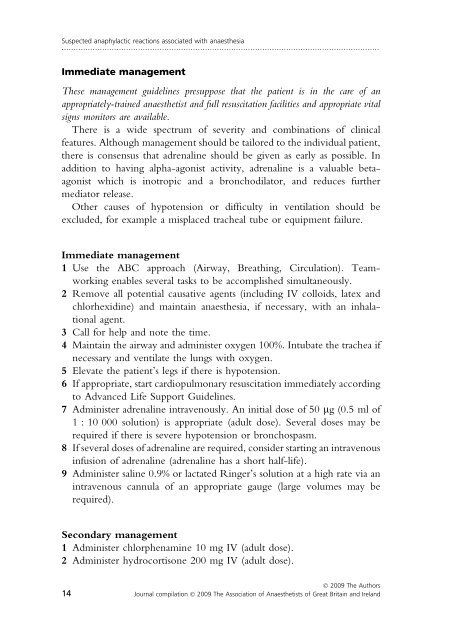Suspected anaphylactic reactions associated with anaesthesia - aagbi
Suspected anaphylactic reactions associated with anaesthesia - aagbi
Suspected anaphylactic reactions associated with anaesthesia - aagbi
- No tags were found...
You also want an ePaper? Increase the reach of your titles
YUMPU automatically turns print PDFs into web optimized ePapers that Google loves.
<strong>Suspected</strong> <strong>anaphylactic</strong> <strong>reactions</strong> <strong>associated</strong> <strong>with</strong> <strong>anaesthesia</strong>.....................................................................................................................................Immediate managementThese management guidelines presuppose that the patient is in the care of anappropriately-trained anaesthetist and full resuscitation facilities and appropriate vitalsigns monitors are available.There is a wide spectrum of severity and combinations of clinicalfeatures. Although management should be tailored to the individual patient,there is consensus that adrenaline should be given as early as possible. Inaddition to having alpha-agonist activity, adrenaline is a valuable betaagonistwhich is inotropic and a bronchodilator, and reduces furthermediator release.Other causes of hypotension or difficulty in ventilation should beexcluded, for example a misplaced tracheal tube or equipment failure.Immediate management1 Use the ABC approach (Airway, Breathing, Circulation). Teamworkingenables several tasks to be accomplished simultaneously.2 Remove all potential causative agents (including IV colloids, latex andchlorhexidine) and maintain <strong>anaesthesia</strong>, if necessary, <strong>with</strong> an inhalationalagent.3 Call for help and note the time.4 Maintain the airway and administer oxygen 100%. Intubate the trachea ifnecessary and ventilate the lungs <strong>with</strong> oxygen.5 Elevate the patient’s legs if there is hypotension.6 If appropriate, start cardiopulmonary resuscitation immediately accordingto Advanced Life Support Guidelines.7 Administer adrenaline intravenously. An initial dose of 50 lg (0.5 ml of1 : 10 000 solution) is appropriate (adult dose). Several doses may berequired if there is severe hypotension or bronchospasm.8 If several doses of adrenaline are required, consider starting an intravenousinfusion of adrenaline (adrenaline has a short half-life).9 Administer saline 0.9% or lactated Ringer’s solution at a high rate via anintravenous cannula of an appropriate gauge (large volumes may berequired).Secondary management1 Administer chlorphenamine 10 mg IV (adult dose).2 Administer hydrocortisone 200 mg IV (adult dose).Ó 2009 The Authors14 Journal compilation Ó 2009 The Association of Anaesthetists of Great Britain and Ireland

















